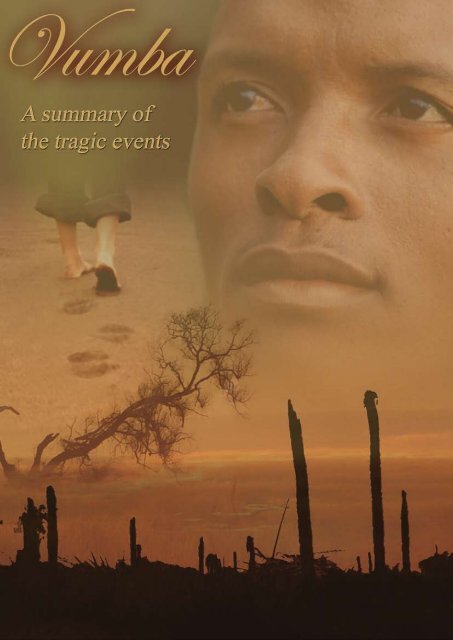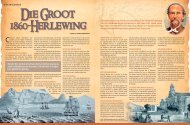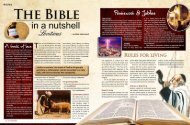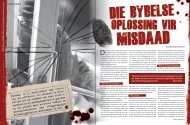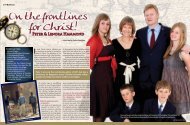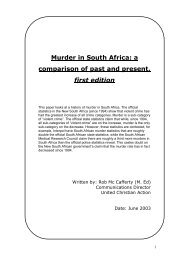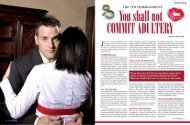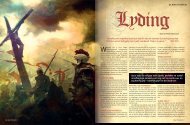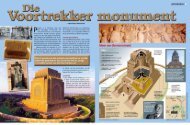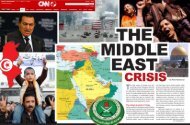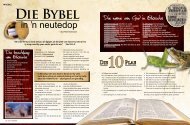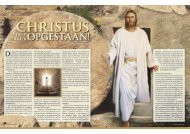The Vumba Tragedy - Elim Missions
The Vumba Tragedy - Elim Missions
The Vumba Tragedy - Elim Missions
You also want an ePaper? Increase the reach of your titles
YUMPU automatically turns print PDFs into web optimized ePapers that Google loves.
<strong>The</strong> <strong>Vumba</strong> <strong>Tragedy</strong><br />
A Summary of the Tragic Events<br />
Friday 23 June 1978 is remembered as being the darkest day in <strong>Elim</strong> history. On that day, twelve people were<br />
slaughtered at the <strong>Elim</strong> Mission station in the <strong>Vumba</strong> Mountains, Northern Zimbabwe. Another would die a<br />
week later. <strong>The</strong> sheer brutality of this massacre shocked the world.<br />
We hope the following will not only give you an insight into the history of the <strong>Vumba</strong> <strong>Tragedy</strong> but also inspire<br />
and challenge you as to the part you are playing in world mission.<br />
<strong>The</strong> Missionaries in Rhodesia…<br />
Peter and Sandra McCann, Philip (6) and Joy (4)<br />
Philip and Susanne Evans and Rebecca (5)<br />
Roy and Joyce Lynn and Pamela Grace (3 weeks old)<br />
Wendy White<br />
Catherine Picken<br />
Mary Fisher<br />
Joy Bath (nurse) and Peter Griffiths (Principal of the <strong>Elim</strong> School) were in the UK at the time of the massacre.<br />
Background…<br />
From the earliest times, most British Pentecostal missionaries were talented. In Rhodesia (now Zimbabwe),<br />
the leader in the work from 1948 was Doctor Cecil Brien and his wife. With their medical and surgical skills,<br />
they saw a substantial reduction in infant mortality in the area. <strong>The</strong> future growth of the work in Rhodesia was<br />
to further develop both in the hospital and more particularly in the school.<br />
At the time of the tragedy, the missionaries out on the field were both talented<br />
and highly qualified. Three of them had science degrees. Peter McCann (teacher)<br />
had a B.Sc degree as did Philip Evans (teacher), who also had an M.Sc. Roy<br />
Lynn was a whiz with mechanics and Joyce was a nurse/midwife. Wendy White<br />
had a degree in social studies as well as being a nurse. Catherine was a sports<br />
teacher. Mary Fisher (teacher) had a B.Sc degree and had studied at London<br />
Bible College as well as at Swansea and Brunel University.<br />
Cecil Brien at work<br />
Philip Evans had first gone out to Rhodesia at the end of December 1975. On his<br />
arrival he was presented with papers by the authorities and was asked to sign them.<br />
Included in these was a section that required him to agree as a layman to take up arms<br />
if hostilities broke out. This he refused to do and he was sent home again. When he<br />
returned to the UK, <strong>Elim</strong> ordained him as a minister and he went back again and was<br />
admitted to the country.<br />
<strong>The</strong> McCann Family<br />
leaving for <strong>Vumba</strong><br />
Irishman Robert Lynn, who was familiar with troubles in his own country, had access<br />
to a gun, which was mainly used for shooting snakes and vermin. However he, together<br />
with the others, agreed that this should be surrendered in keeping with the mission’s<br />
strict neutrality.
Zimbabwe <strong>The</strong>n…<br />
At this particular time in history, Rhodesia was in<br />
conflict; the forces of the Rhodesian government<br />
under Prime Minister Ian Smith opposing the socalled<br />
“liberation” forces led by Joshua Nkomo and<br />
Robert Mugabe (now President of Zimbabwe).<br />
Leslie Wigglesworth (the International <strong>Missions</strong><br />
Director) and David Ayling kept in close touch<br />
with the British Foreign and Commonwealth<br />
Office to ascertain the safety of their workers in<br />
Rhodesia. One interview took place in the office of<br />
the Labour Foreign Secretary, David Owen. Some<br />
time later in a television interview which dealt with<br />
David Owen’s personal faith, he paid tribute to the<br />
two <strong>Elim</strong> ministers. <strong>The</strong>y had asked to pray with<br />
the Foreign Secretary and were permitted to do so.<br />
David Owen said that it had impressed him greatly<br />
and that it was probably the first time such a thing<br />
had happened in that office!<br />
At the time it seemed wise to move the <strong>Elim</strong> School<br />
and hospital from their premises at Nyanga North<br />
(also known as Katerere) to the <strong>Vumba</strong>, because<br />
of safety precautions. <strong>The</strong>re was an army base a<br />
few miles from the school and hospital at Katerere<br />
and the so-called Patriotic Front freedom fighters<br />
were increasingly active. <strong>The</strong> <strong>Vumba</strong> is in the hills<br />
above Mutare, about 100 miles from Katerere,<br />
and is situated only a very short distance from the<br />
border with Mozambique.<br />
John Smyth, a senior staff member at <strong>Elim</strong><br />
Headquarters, had been delegated by the Executive<br />
Council and the International <strong>Missions</strong> Board<br />
to go to Rhodesia to share with Ron Chapman,<br />
the Chairman of the work there. Together they<br />
consulted the teachers and nurses who served at the<br />
Mission at Katerere and also at the Eagle School<br />
in the <strong>Vumba</strong>. Every one of the <strong>Elim</strong> missionaries<br />
bravely and unstintingly opted to stay in Rhodesia<br />
to continue with their work. Arrangements were<br />
made to evacuate them in the event of an impending<br />
disaster.<br />
Ron Chapman<br />
<strong>The</strong> situation<br />
became more<br />
serious and moving<br />
became imperative.<br />
A member of<br />
the International<br />
<strong>Missions</strong> Board<br />
was sent to discuss<br />
the possible move<br />
<strong>Vumba</strong> Mountains in Zimbabwe<br />
to the Eagle School at the <strong>Vumba</strong>, a move which was<br />
not initially favoured because of the separation between<br />
the hospital and the school. It must be remembered<br />
that the staff at the school and hospital ran churches in<br />
the Katerere area as well as following their nursing or<br />
teaching ministries. <strong>The</strong> nursing staff also ran clinics.<br />
However, the International <strong>Missions</strong> Board member<br />
readily agreed to the move once the whole position had<br />
been assessed.<br />
At this time, Joyce Pickering had become engaged to<br />
Roy Lynn. <strong>The</strong>ir marriage took place in the UK on 23<br />
July 1977. Joan Caudell (a teacher) and Joy Bath were<br />
due to go on furlough. Wendy White, who was due to go<br />
on leave on 3 July 1978, was a nurse at the hospital, but<br />
her degree meant that she could teach when the move to<br />
the <strong>Vumba</strong> took place. She taught Biology and English.<br />
Her nursing skills were invaluable especially as she was<br />
to be the only nurse on site at the <strong>Vumba</strong>.<br />
Ron Chapman (Chairman) was regularly in touch with<br />
the school and taught Bible Knowledge two days a week.<br />
<strong>The</strong> teaching staff were the most highly qualified of any<br />
African school in Rhodesia. <strong>The</strong>y were well able to teach<br />
their scholars at secondary level.<br />
One of the main challenges facing the staff at Katerere<br />
was the land mines which had been laid everywhere.<br />
One of the lorries belonging to the Mission was badly<br />
damaged in an explosion. After one particular journey<br />
that Peter Griffiths (Principal of the <strong>Elim</strong> School) and<br />
Joan Caudell made, they found out that they had passed<br />
over several land mines without them exploding! Because<br />
of the tremendous risks involved in travelling, it became<br />
increasingly difficult to provide meals for up to 1,000<br />
people on the site in Katerere.
Move to <strong>Vumba</strong> …<br />
<strong>The</strong> Eagle School had been a preparatory school for European<br />
boys. It could accommodate about 150, whereas the <strong>Elim</strong> School<br />
needed twice that number. When the <strong>Elim</strong> School moved there,<br />
the scholars accepted the available accommodation despite many<br />
having to sleep on mattresses on the floor. <strong>The</strong>y were just glad to<br />
be able to continue their secondary education.<br />
Peter Griffiths and School children<br />
Peter Griffiths and his wife<br />
Brenda, took a lengthened<br />
leave and returned to the<br />
UK in August 1977 for<br />
Peter to complete his MA<br />
studies. Philip Evans was<br />
made Acting Principal in<br />
the absence of Peter. Philip<br />
was only 28 and serving his<br />
first term, but he accepted<br />
the challenge.<br />
Every one of the <strong>Elim</strong> missionaries bravely and<br />
unstintingly opted to stay in Rhodesia to continue<br />
with their work.<br />
<strong>The</strong> British teachers first impression of the <strong>Vumba</strong> was that it was<br />
like the English Lake District, so beautiful was this mountainous<br />
area. It was 15 miles from Mutare, which meant ready access to<br />
shops and wider Christian fellowship.<br />
<strong>The</strong> school at Katerere was disbanded. One tragic event was<br />
that two of three double decker buses, which were transporting<br />
scholars, were seriously damaged by land mines. Two of the<br />
boys were killed and one lost a leg. <strong>The</strong> occupants on one of the<br />
buses lost all their possessions.<br />
<strong>The</strong> move to the Eagle School, <strong>Vumba</strong> happened in 21 July<br />
1977.<br />
Timothy and Rachel Evans, the two older children of Philip<br />
and Susanne Evans, were at boarding school in Salisbury (now<br />
Harare). Philip Evans’ mother visited the whole family at the<br />
<strong>Vumba</strong> so was able to make meaningful contact with the whole<br />
family before the massacre. She bravely and lovingly took Tim<br />
and Rachel into her care after the <strong>Vumba</strong> tragedy.<br />
Joyce and Roy Lynn’s baby daughter, Pamela Grace, was<br />
delivered two weeks early by Caesarian section in hospital in<br />
Mutare on 1 June 1978. Had the baby gone to full term, she<br />
and Joyce would have been safe in hospital at Mutare when the<br />
massacre occurred.<br />
<strong>The</strong> Evans Family<br />
<strong>The</strong> <strong>Elim</strong> workers felt safe<br />
at the <strong>Vumba</strong> as it was well<br />
protected. While there, Joyce<br />
Lynn opened four clinics<br />
in nearby areas while her<br />
husband Roy preached and ministered to the men.<br />
Visits were made once a month to the hospital at<br />
Katerere by staff from the <strong>Vumba</strong>, courtesy of the<br />
marvellous service provided by the small planes<br />
of the Missionary Aviation Fellowship. MAF<br />
transported <strong>Elim</strong> missionary personnel as well as<br />
personnel from other missionary organisations.<br />
<strong>The</strong>ir help was invaluable. In many cases it would<br />
have otherwise been totally impossible to gain<br />
access to the mission stations because of guerilla<br />
activity.<br />
<strong>The</strong> first term at the <strong>Vumba</strong> went very well, but<br />
the second term proved to be very difficult due to<br />
increasing guerilla activity and influence in the<br />
country. <strong>The</strong> African House Master came under<br />
such pressure that he was obliged to leave. Six boys<br />
disappeared, probably to join the guerillas. Food<br />
was stolen and probably supplied to the guerillas,<br />
which put the staff under enormous pressure from<br />
the Government forces for allegedly supporting<br />
the so-called rebels. Consequently, no food was<br />
kept in store at the school. Instead, supplies were<br />
obtained daily from Mutare. It was nonetheless<br />
felt that scholastically and spiritually the scholars<br />
progressed at the <strong>Vumba</strong>.<br />
Ron Chapman kept in<br />
close touch with the<br />
church authorities<br />
in Cheltenham, but<br />
events mounted<br />
because Roman<br />
Catholic, Dutch<br />
Reformed, Salvation<br />
Army and American<br />
From Left - Catherine, Mary,<br />
Roy and Joyce<br />
Southern Baptist workers were murdered. <strong>The</strong><br />
Roman Catholic and Salvation Army schools had<br />
been disbanded. <strong>The</strong> killing of two Salvation Army<br />
lady teachers sent shock waves all over the world.<br />
<strong>The</strong> work of their organisation in Rhodesia was<br />
large, highly esteemed and very well known. No one<br />
thought that their personnel would be murdered.<br />
Alarmed by this news, Leslie Wigglesworth phoned<br />
Ron Chapman in Rhodesia and it was decided that<br />
the staff should move to Mutare and travel in to the<br />
school every day. Matters were not helped because<br />
all the staff members, except Wendy White, were<br />
unwell. Every staff member said yet again that they<br />
wished to continue their work at the school. <strong>The</strong><br />
International <strong>Missions</strong> Board sent Peter Griffiths to<br />
Rhodesia 19 October 1977. This brief visit resulted<br />
in the staff again expressing their desire to stay<br />
where they were.
So came the tragic events of 23rd June 1978…<br />
21 Guerillas came over the border from Mozambique and<br />
attacked the missionaries with axes and other weapons. <strong>The</strong><br />
inquest revealed the terrible punishment and mutilation that they<br />
suffered. One guerilla later said that the “executions” were in<br />
retaliation for a Rhodesian Army attack on a guerilla camp two<br />
years earlier, which the <strong>Elim</strong> missionaries knew nothing about.<br />
Ron Chapman was called upon to go to the Eagle School on the<br />
day of the murders to identify the victims and to deal with the<br />
immediate aftermath. All the deceased, including three week old<br />
baby Pamela Grace, had been brutally ill-treated, abused and<br />
murdered. <strong>The</strong> bodies were almost unrecognisable. Altogether<br />
there were three men, five women and four children.<br />
Mary Fisher was cruelly attacked, but managed to run down<br />
the steep hill on which the school stands, going through<br />
agonizingly prickly bushes and trees. She was found later and<br />
taken unconscious to hospital in the capital, Harare, where she<br />
died on 30 June 1978. Mary should have been setting off for<br />
her furlough that day. Her departure was delayed because she<br />
wanted to visit her sister who was on missionary work in Ghana<br />
before returning to Britain. <strong>The</strong> travel arrangements had proved<br />
to be immensely difficult involving detours through other<br />
African countries, thus delaying her departure.<br />
On the day of the tragedy, Mr Chapman tried to phone <strong>Elim</strong><br />
Headquarters without success, but managed to get through to<br />
the <strong>Elim</strong> Bible College at Capel, Surrey. He was able to speak<br />
to Wesley Gilpin, Principal of the College. It so happened that<br />
it was Open Day there and the main speaker was Peter Griffiths.<br />
Wesley Gilpin had the unenviable task of informing Peter of the<br />
situation as he and Brenda arrived at the College. Peter stood<br />
high, greatly admired by everybody, because he proceeded to<br />
minister at the crowded Open Day despite the devastating news<br />
from Rhodesia. His ministry was tremendously moving, brave<br />
and challenging. Amazingly, what he had prepared on Hebrews<br />
11:24,25 could not have been more fitting. It even included the<br />
illustration of the five American missionaries murdered by the<br />
Auca Indians in South America.<br />
Shock…<br />
<strong>The</strong>re was worldwide condemnation of the needless slaughter.<br />
Politicians, churchmen and journalists all joined in the chorus.<br />
It was an especially difficult time for <strong>Elim</strong> <strong>Missions</strong>. <strong>The</strong> long<br />
serving <strong>Missions</strong> Director, Leslie Wigglesworth had just retired<br />
and his successor, David Ayling (minister of Ulster Temple,<br />
Belfast) had not yet moved into the office.<br />
Digging the graves<br />
<strong>The</strong> news rocked the whole<br />
<strong>Elim</strong> movement. On Sunday<br />
25 June special services were<br />
held in <strong>Elim</strong> churches all over<br />
Britain. <strong>The</strong> Cheltenham <strong>Elim</strong><br />
Church (next door to <strong>Elim</strong><br />
International Offices) was<br />
packed for the Sunday morning service. Many<br />
representatives of the media were there. Some went<br />
into the service and came out astonished. <strong>The</strong>y<br />
could not get over the fact that the congregation, led<br />
by their minister Rev Lionel Currie, were praying<br />
for the very people who had committed the murders<br />
as well as for relatives and friends of the deceased.<br />
<strong>The</strong> media gave special attention to the prayer<br />
offered at Cheltenham <strong>Elim</strong>. <strong>The</strong> Daily Mail of<br />
26 June carried the heading, ‘Father…forgive<br />
them’. This viewpoint, which was given to the<br />
media and propagated by them, gave rise to a very<br />
mixed response in the UK. <strong>The</strong>re were those who<br />
applauded such a Christian standpoint while a few<br />
indicated that such a view was totally repulsive to<br />
them. It seemed to be the view that <strong>Elim</strong> should<br />
have cried for immediate reprisals and for those<br />
who had committed these atrocities to be brought<br />
to justice.<br />
Funeral service<br />
<strong>The</strong> International <strong>Missions</strong> Board was called to<br />
meet that same day. It was decided unanimously<br />
that International <strong>Missions</strong> Board members should<br />
leave in twos to visit the homes of those who had<br />
been murdered and to seek to arrange for their<br />
future welfare.<br />
Leslie Wigglesworth and David Ayling along<br />
with John Smyth were selected to attend the<br />
funeral service in Rhodesia. Tom Walker, Field<br />
Superintendent, remained behind to deal with the<br />
vast number of phone calls, interviews and requests<br />
for information. He was at his post from 6 am until<br />
11 pm every day for a week.<br />
Radio and television people requested interviews.<br />
One interviewer from Australia did a very<br />
demanding interview over the phone which was<br />
broadcast live over Australian television.<br />
<strong>The</strong> lovely thing was that every now and then the<br />
unending calls would include one from an <strong>Elim</strong><br />
minister. Without exception, each one lovingly<br />
said, “We are standing with you and praying for<br />
you!”. Each supportive call was brief, but so deeply<br />
appreciated.
Back in Zimbabwe…<br />
.. the scene was devastating. Students and African<br />
personnel had left the area. Zimbabwean friends were<br />
trying to bring some order into the chaos, but the<br />
situation was nevertheless dark and depressing.<br />
<strong>The</strong>re was worldwide condemnation of the<br />
needless slaughter.<br />
<strong>The</strong> first funeral service was for all those killed except<br />
for Mary Fisher, and was held in Mutare. A fleet of<br />
hearses from the main cities of Rhodesia were required<br />
to accommodate the funeral. <strong>The</strong> service was led by<br />
Mr Ron Chapman and David Ayling preached. John<br />
Smyth conducted the burial service and Ron Chapman<br />
preached.<br />
Mary Fisher’s funeral was held on the following<br />
Thursday. John Smyth led the funeral service and<br />
conducted the burial service and Ron Chapman<br />
preached. <strong>The</strong> verse quoted at the time of the deaths<br />
and on the memorial was, “For to me to live is Christ,<br />
to die is gain”.<br />
During the funeral service, Ron Chapman had prayed<br />
for the families of those who had been killed. He also<br />
prayed for those who were responsible for the killings.<br />
Some of the papers reported that the Mayor of Mutare<br />
took objection to this.<br />
<strong>The</strong> question of forgiveness had become a very<br />
controversial issue in Zimbabwe. Nevertheless Peter<br />
Griffiths and the others maintained that this was the<br />
Christian thing to do.<br />
To Date and Answers to Prayer…<br />
We now know that the same prayer of forgiveness was prayed<br />
by some of the missionaries as they were being killed. It also<br />
came to light that this prayer was beginning to be answered<br />
- rumours began to circulate in the early 1980’s that several<br />
of the men personally responsible for the killings had been<br />
dramatically converted.<br />
Peter Griffiths returned to Zimbabwe. In January 1979, after<br />
settling back into the work, he was given a senior position<br />
in the Education Department in the newly independent<br />
Zimbabwe. <strong>The</strong> International <strong>Missions</strong> Board asked him to<br />
investigate to see what substance there was in these rumours.<br />
Peter was able to confirm the remarkable story of what<br />
happened to a group in the platoon who were together in an<br />
army camp in Entumbane shortly after the war had ended.<br />
Eight of them<br />
experienced a<br />
vision in which<br />
they saw the cross<br />
and the hand<br />
of God coming<br />
against them in<br />
judgment. Seven<br />
of them who<br />
had passports<br />
immediately left the country and enrolled in Bible Schools in<br />
West and East Africa. <strong>The</strong> other, not having a passport went<br />
to a Bible School in Harare where Peter Griffiths was able to<br />
meet him. He had left school at 14 and had been the youngest<br />
platoon commander in ZANLA, operating under the name of<br />
‘War Devil’. Peter subsequently kept in regular touch with<br />
him.<br />
In another separate incident, an African pastor named<br />
Mopofu, working for Harare Intecessors, was asked to speak<br />
at a rehabilitation centre for ex-combatants in Troutbeck,<br />
Nyenga. While he was preaching, a paraplegic man screamed<br />
out in agony out of deep conviction, crying for mercy. He later<br />
confessed that he had been one of those responsible for killing<br />
the missionaries. He told the pastor how the missionaries had<br />
prayed for their killers as they were being slaughtered.<br />
<strong>The</strong> <strong>Elim</strong> missionaries suffered because they happened to<br />
have moved into a new area at the wrong time. <strong>The</strong>y were at<br />
a location that straddled one of the main routes of entry for<br />
bands of freedom fighters; they had not been in the area long<br />
enough to build up the respect and trust of the locals in the<br />
same way that they had been able to do in Katerere.<br />
Some of the Africans also suffered during the conflict,<br />
particularly in the more rural areas. Some churches were<br />
closed. Pastor Abraham Satuku was badly beaten after<br />
being falsely charged in July 1977. If it hadn’t been for the<br />
intervention of a guerrilla commander, Pastor Satuku would<br />
have been killed. In a remarkable turn of events, the guerilla
commander said that he would be willing to die alongside<br />
Pastor Satuku if the beating did not stop.<br />
Dr David J Maxwell, Editor of the Journal of Religion<br />
in Africa, who was a teacher in Zimbabwe from 1986 to<br />
1989, writes:<br />
“<strong>The</strong> war left the Church in the hands of the local people.<br />
<strong>The</strong>y did not simply appropriate its structures but also its<br />
religious authority. <strong>The</strong> new structures of the Zimbabwean<br />
Church reflected this with its greater emphasis on<br />
lay vocation and<br />
Rumours began to circulate<br />
that several of the men<br />
responsible for the killings<br />
had been dramatically<br />
converted.<br />
an indigenous<br />
leadership. This<br />
renewed closeness<br />
with its base made<br />
it responsive to the<br />
needs of rural people in post-war society. <strong>The</strong> Church<br />
offered them the chance to come to terms with and heal<br />
memories of the war through acts of confession and<br />
restitution. Christians have found meaning for the pain<br />
they experienced through concepts of reconciliation,<br />
sacrifice and, in the specific case of <strong>Elim</strong>, martyrdom. This<br />
dynamic continues today as Christians draw inspiration<br />
from the war through the idioms of testimony and song as<br />
a means to help overcome the hardships of the present.”<br />
Finally…<br />
As a result of the attitude of forgiveness and prayer,<br />
we have seen the work in Zimbabwe flourish rather<br />
than diminish. <strong>The</strong> secondary school is now twice<br />
the size it was before the massacre and the hospital<br />
is making excellent progress not only in treatment<br />
but also in relationships with the government. <strong>The</strong><br />
church is growing and 16 new churches were planted<br />
between 1993 and 2003. Following the massacre,<br />
many people gave funds for a church to be bought as<br />
a memorial tribute and the Mutare Memorial church<br />
was purchased. <strong>The</strong> church continues to flourish<br />
and services are full to overflowing.<br />
What happened in Zimbabwe is not something that<br />
any of us would ever wish to see again, but heaven<br />
must have rejoiced at the dedication, faithfulness and<br />
loyalty of the devoted missionaries. In the plan and<br />
purposes of God, He saw fit to take these workers<br />
home to Himself. It is also clear that the principles<br />
of sowing and reaping are eminently worked out in<br />
each human life, that as we die, so we live.<br />
<strong>The</strong>se missionaries were truly ”promoted to Glory”.<br />
<strong>The</strong> plaque we maintain here at <strong>Elim</strong> International Offices reads as follows:
<strong>The</strong> Missionaries:<br />
Robert John Lynn (known as Roy)<br />
Born on 21 September 1941, Roy was 36 when he was killed. Roy was originally intended as a temporary replacement<br />
for missionary Alan Renshaw who was on leave and who was normally in charge of maintenance. Roy had a<br />
magic touch with all machinery. He was lame and became especially loved by the Africans because if he fell over<br />
while doing a repair, he got up and laughed! He would do anything for anybody. When he left for Rhodesia in 1975<br />
after pastoring the <strong>Elim</strong> Church in Brookeborough, Northern Ireland, for over 6 years, he had to change planes at<br />
Heathrow airport. He was met in from Belfast by P S Brewster and Tom Walker from <strong>Elim</strong> Headquarters. <strong>The</strong>y were<br />
surprised to see him walking towards them with a much more pronounced limp than usual. He was carrying two cases,<br />
one a fibre one and the other full of tools. He greeted the two men with the remark, ”I have had another road accident<br />
and I knew that if I told you about it, you would not let me go to Rhodesia. It’s too late now and I’m off!” <strong>The</strong> men<br />
were very moved and even found emotional difficulty in praying for this brave young man just before he left.<br />
Joyce Lynn nee Pickering<br />
Born on 16 November 1941, Joyce was 36 when she was killed. Joyce was from York and was a highly skilled nurse<br />
and midwife. She met Roy in Rhodesia. <strong>The</strong>y were married in the UK on 23 July 1977. <strong>The</strong>ir daughter, Pamela Grace,<br />
was born on 1 June 1978, just 3 weeks before her tragic death. Joyce was the very capable Matron of the Hospital, a<br />
good organiser and very successful in pursuit of her nursing and midwifery ministry.<br />
Elizabeth Wendy H White (known as Wendy)<br />
Born on 14 June 1940, Wendy was 38 when she was killed. She was from Kensington Temple and was well experienced<br />
in nursing, teaching and social work, holding BA, SRN and a Diploma in Social Studies qualifications. She<br />
served in Rhodesia for 1 year 4 months, and was still on her first term when she was killed.<br />
Peter and Sandra McCann<br />
Born on 13 April 1946 and 30 December 1943, Peter and Sandra were 32 and 34 respectively when they were killed.<br />
<strong>The</strong>y were both from Huddersfield, Yorkshire and served in Rhodesia for almost 8½ years. <strong>The</strong>ir first child Paul, tragically<br />
died with the first whiff of anaesthetic on the operating table seven years before the <strong>Vumba</strong> massacre and Peter<br />
and Sandra were remarkable in their wonderful response to such a tragedy. Peter was a well qualified science teacher<br />
and highly skilled in laboratory work. Sandra was very adept with needlework and handicrafts. <strong>The</strong>ir children Philip<br />
aged nearly 6 and Sharon aged 4½ were killed with them.<br />
Philip and Susanna Evans<br />
Born on 16 April 1949 and 12 July 1945, Philip and Susanna were 29 and 33 respectively when they were killed. <strong>The</strong>y<br />
were from Nuneaton <strong>Elim</strong>. <strong>The</strong>ir daughter Rebecca was killed with them. She was only 5. <strong>The</strong>y ministered in Rhodesia<br />
for 2½ years and were still on their first term. Philip held MSc, MPhil, and Teaching Diploma qualifications. Sue<br />
was a qualified secretary. <strong>The</strong>ir children Timothy and Rachel (highlighted in photo) were away at boarding school at<br />
the time of the tragedy and therefore survived. <strong>The</strong>ir grandmother, Philip’s mother, took over the responsibility of their<br />
care in England. Timothy was born on 22 April 1968 and Rachel on 14 August 1969, so they were 10 and almost 9<br />
when they lost their parents.<br />
Catherine Picken<br />
Born on 15 March 1923, Catherine was from Southend on Sea and 55 at the time of the <strong>Vumba</strong> massacre. She was a<br />
proficient hockey player and sports teacher, a role she was still occupying at the time of her death. She studied French<br />
and other subjects in Belgium for 2 years from 1956 in preparation for missionary work in Congo. She served there for<br />
1½ years and had to escape at the time of the Katanga war. She served in Rhodesia for almost 18 years.<br />
Mary E Fisher<br />
Born on 13 August 1946, Mary was 31 when she died in hospital in Harare. Mary was from Caerphilly and taught<br />
maths and science. She went to Rhodesia in August 1973 and had served for almost 5 years. She had a rich soprano<br />
voice and her worship tapes were a great blessing both before and after her tragic death. She survived the initial attack,<br />
only to die from her terrible injuries on 30 June 1978.
(Left to right) Back Row: Brenda & Peter Griffiths, Alan<br />
Renshaw Front Row: Catherine Picken, the Drs Brien, Joan<br />
Caudell, Roy Lynn and Anne Renshaw<br />
Mary Fisher<br />
<strong>The</strong> McCann family and<br />
Catherine Picken<br />
Dr Brien, Catherine Picken and Peter Griffiths<br />
Peter Griffiths, David Ayling and John Smyth with Evelyn<br />
and Pious Munembe<br />
Philip and Susanna<br />
Evans<br />
<strong>The</strong> Evans and McCann<br />
families<br />
<strong>The</strong> <strong>Vumba</strong><br />
Memorial<br />
Church<br />
<strong>The</strong>n (left) …<br />
… and now<br />
(right)<br />
<strong>Elim</strong> International <strong>Missions</strong><br />
<strong>Elim</strong> International Centre, De Walden Rd,<br />
Malvern, WR14 4DF<br />
Tel: 0845 302 6750 / 01684 588 940<br />
Email: missions@elimhq.net


